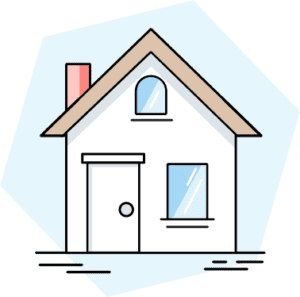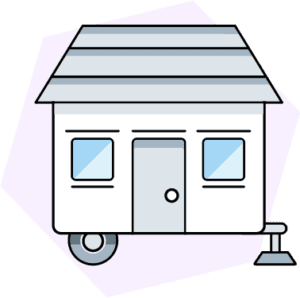Homeowners insurance covers structural problems if they’re caused by a covered peril. Covered perils could vary depending on the insurer and the policy type, but some common ones include fire, windstorms, and lightning strikes.
Most homeowners insurance policies define a home’s structure as anything that provides support, such as the walls, roof, and foundation. Your coverage should kick in if a covered peril damages any structural component of your home.
However, if your home’s structural problems are caused by your negligence or lack of maintenance, most homeowners policies will not help foot the bill to repair the damage.
Table of Contents
- What Is Considered Structural Damage To A Home?
- How Does Homeowners Coverage For Structural Damage Work?
- Which Coverages Apply To Structural Damage?
- When Are Structural Problems Not Covered?
- How Much Does It Cost To Add Coverage For Structural Damage To Your Policy?
- How To Add Coverage For Structural Damage To Your Policy
- Putting It All Together
- Frequently Asked Questions
What Is Considered Structural Damage To A Home?

Structural issues are anything that affects the structural integrity of your home, such as a damaged roof, foundation, or load-bearing wall.
Structural damage to your home can be easy to miss. Pay attention to these signs to spot structural problems early on and save yourself thousands in repair bills:
- Cracks in the walls
- Windows and doors not opening and closing properly
- Uneven flooring
- Bowed or bulging walls
- A cracked or leaning chimney
- Cracks along the front porch
What Causes Structural Problems?
The most common causes of structural damage include but are not limited to the following:
- Natural disasters
- House fires
- Floods
- Labor incidents
- Earthquakes
- Lack of proper maintenance
- Termite infestation
- Water damage
- Poor construction
- Tree roots
While most natural disasters are not preventable, you can take proactive steps to reduce these events’ impact on your home’s structure. For example, weather-proofing your home with the help of a professional and regularly monitoring it for signs of building defects, such as uneven flooring or cracks in the wall.
How Does Homeowners Coverage For Structural Damage Work?
A home with structural problems can be dangerous to live in. If your home is damaged due to a covered peril, your homeowners insurance will provide coverage. How much coverage, however, depends on your exact policy and the extent of the damage.
What Does Homeowners Insurance Typically Cover?
What your homeowners insurance covers for structural damages can vary slightly from policy to policy. The most ‘bare bones’ homeowners insurance policy, also known as HO-1, may cover your home’s structural damage if it’s caused by one of the following:
- Damage from aircraft
- Damage from vehicles
- Explosions
- Fire or lightning
- Hail and windstorms
- Smoke
- Riots and civil commotion
- Vandalism or malicious mischief
- Theft
- Volcanic eruptions
Here’s what your homeowners insurance could cover if you opt for other plans instead of HO-1 policies:
Home Insurance Form Categories | Named or Open Peril | Covered Perils (Structure) | Covered Perils (Possessions) | Exclusions |
|---|---|---|---|---|
HO-2, or 16 Named Perils Insurance | Named | Same as HO-1, plus:• Freezing• Falling objects• Weight of ice, snow, or sleet• Cracking, bulging• Artificially generated electric current• Water or stream | Same as covered perils for structure | All standard exclusions, plus water damage caused by sewer or drain backups |
HO-3, or Standard Home Insurance | •Structure: Open•Possessions: Named | All except standard exclusions | Same as HO-2 | All standard exclusions |
HO-4, or Renter’s Insurance | Named | None | Same as HO-2 | All standard exclusions |
HO-5, or Open Perils Insurance | Open | All except standard exclusions | N/A | All standard exclusions |
HO-6, or Condo Insurance | Named | None; covered by master condo insurance policy | Same as HO-2 | All standard exclusions |
Understanding Covered Perils
Covered perils are unpredictable events or hazards that could cause damage to your property. There are generally two types of homeowners insurance coverage: Named or open peril. Under a named-perils policy, only specifically listed perils are covered.
On the other hand, with an open-perils policy, everything is covered unless specifically excluded. If you have open-perils homeowners insurance, be sure to carefully review the exclusions listed in the policy so you know what events are not covered.
Which Coverages Apply To Structural Damage?
Homeowners insurance includes three main components: Dwelling coverage, personal property, and personal liability.
Dwelling
Dwelling coverage is the portion of a standard homeowners insurance policy that helps shoulder the cost of repairing or rebuilding your home — including the structure — if a covered peril damages it. Covered perils can vary by policy type, but common ones include windstorms, fire, lightning, and smoke.
Personal Property

Personal property is part of a standard homeowners insurance that helps cover the cost of your personal items if they’re damaged in the event of a covered loss. The coverage limit varies depending on your policy and insurer, but it’s usually up to $100,000. Most homeowners insurance policies cover damage to your personal belongings, except for HO-1.
Loss of Use
Loss of use coverage helps cover your living expenses when your primary residence becomes uninhabitable due to a covered peril. This coverage will pay for a hotel or rental home after a fire, moving costs, and more. It’s typically calculated at around 10% to 30% of your dwelling coverage limit. Your standard homeowners insurance policy typically includes loss of use coverage.
When Are Structural Problems Not Covered?
Homeowners insurance policies generally will not help shoulder the cost of a home’s structural repairs if the problem was not caused by a covered peril. For example, if the structural damage arose from pest infestation or a lack of maintenance, most insurers will not help pay for the repair costs since these problems are preventable.
Remember that coverage exclusion can vary by the type of insurance you purchase, so check with your homeowners insurance agent to understand what’s covered and what’s not.
How Much Does It Cost To Add Coverage For Structural Damage To Your Policy?
Standard homeowners insurance policies usually cover structural damage under dwelling coverage. How much you pay for this coverage depends on the insurance policy type, the insurer, your home’s replacement value and condition, etc.
Home Insurance Form Categories | Average Cost of Coverage For Structural Damage |
|---|---|
HO-2, or 16 Named Perils Insurance | $1,175/Year |
HO-3, or Standard Home Insurance | $1,311/Year |
HO-4, or Renter’s Insurance | N/A |
HO-5, or Open Perils Insurance | $1,471/Year |
HO-6, or Condo Insurance | N/A |
Data sourced from the National Association of Insurance Commissioners (NAIC), 2020
How much your insurance costs will depend on the specific type of peril. Standard homeowners insurance covers some perils such as fire and lightning. However, structural damages by earthquakes and floods are generally not covered unless you purchase supplemental insurance.
Take a look below at how your costs can vary depending on the peril that damaged your house.
Peril | Average Cost of Coverage For Structural Damage | Notes |
|---|---|---|
Natural Disasters | $1,311/Year | Standard homeowner’s insurance covers structural damage caused by natural disasters, except for floods or earthquakes. |
House Fires | $1,311/Year | |
Floods | $935/Year | |
Labor Incidents | $1,311/Year | Standard homeowners insurance may help cover the repair costs if a contractor accidentally causes a house fire or some other damage. |
Earthquakes | $850/Year | |
Lack of Proper Maintenance | N/A | Most insurers will not provide coverage for a preventable issue. |
Termite Infestation | N/A | Most insurers will not provide coverage for a preventable issue. |
Water Damage | $935/Year | |
Poor Construction | N/A | Typically, most homeowners insurance policies only cover good construction or workmanship. |
How To Add Coverage For Structural Damage To Your Policy

To enhance protection against structural problems, consider looking into supplemental policies that can be added to your homeowners insurance for specific risks, such as earthquake insurance or flood insurance.
Here’s how to add additional coverage to your homeowners insurance policy to ensure you’re financially protected if your home’s structure becomes compromised.
- Review your current coverage. Take a look at your existing homeowners insurance policy to understand the coverage limits and exclusions related to structural damage. Knowing this information helps you determine whether you’ll need additional coverage.
- Assess your coverage needs. Your coverage needs depend on factors such as your home’s condition and the specific risks the property may be exposed to. For example, supplemental or stand-alone earthquake insurance could be beneficial if you live in an earthquake-prone area like California.
- Research supplemental policies. Once you know what additional coverage you need, it’s time to research supplemental policies on the market to find an option that best suits your situation. When narrowing down your options, compare coverage limits, premiums, and exclusions.
- Contact an insurance agent. After deciding on a supplemental insurance policy, contact an insurance agent from the company to discuss adding additional coverage to your existing policy. They can guide you through the process and help you understand any changes to your premium.
Putting It All Together
Repairing a home with a damaged structure can cost upwards of five figures. Without adequate homeowners insurance coverage, you may have to bear these expenses out of pocket, which could be financially devastating. If you have not already, take the time to understand the coverage limits and exclusions of your existing homeowners insurance policy to protect your home and your wallet.
